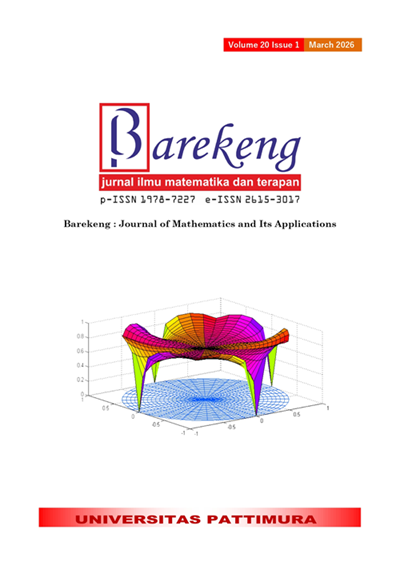MODIFIED STATISTICAL-BASED VALUE AT RISK FOR MULTI-OBJECTIVE OPTIMAL-BASED PORTFOLIO ANALYSIS OF INDONESIAN STOCK RETURN DISTRIBUTION
Abstract
Basically, all stock investments aim to obtain maximum profit with low risk. The formation of a stock investment portfolio is always accompanied by measuring returns and risks that show its performance. Portfolio risk measurement is often faced with the challenge that returns are not normally distributed, so that measurements using the normality assumption cannot be applied. This study proposes the development of a modification of stock portfolio risk measurement so that it is not limited to the normality assumption. The development is carried out by modifying the calculation of Value at Risk (VaR) to consider the skewness and kurtosis values (hereinafter referred to as modified VaR), so that the normal distribution assumption can be eliminated. As a method for compiling a stock portfolio, the Multi-Objective Optimization technique was chosen because it can modify risk averse so that the risk can be adjusted to the risk profile of each investor and is able to stabilize the mean return value. For its implementation, this paper uses real stock data which of course has returns that are not normally distributed, namely the four Indonesian stocks based on the largest capitalization recorded in January 2025 (blue chip), namely BREN, BBCA, BYAN, and BBRI obtained through finance.yahoo.com. The analysis method is divided into three steps, including multi-objective optimization completion, portfolio return calculation, and finally modified VaR estimation. The results of the study show that BBCA has the largest weight with a portion of more than 40% of the four stocks, so BBCA will be the priority stock for this portfolio. The portfolio formed using multi-objective optimization is proven to have a stable mean return because the portfolio mean return is between several of its constituent stocks (vice versa) which is around 0.01%, and the smallest estimated value of the portfolio modified VaR is 1.67%. Thus, a portfolio based on multi-objective optimization is not only able to create a portfolio that provides a small risk in risk measurement without assuming a normal distribution, but at the same time multi-objective optimization is also able to provide competitive returns with its constituent stocks.
Downloads
References
C.-C. Lee, L. Jiang, and H. Wen, “Two aspects of digitalization affecting financial asset allocation: evidence from China,” Emerging Markets Finance and Trade, vol. 60, no. 4, pp. 631–649, 2024.doi: https://doi.org/10.1080/1540496X.2023.2244142
M. Abrar-ul-haq, “Board Structure and Executive Compensation for R&D Spending in Innovative Companies Amid COVID-19,” Journal of Risk and Financial Management, vol. 18, no. 2, p. 69, 2025.doi: https://doi.org/10.3390/jrfm18020069
M. Lipton, “Game against nature: theories of peasant decision-making,” in Rural development, Routledge, 2023, pp. 258–268. Doi: https://doi.org/10.4324/9781003431763-19
M. de Jong McKenzie, “Young investors, precariousness, and the maturing asset economy,” Finance and Society, pp. 1–15, 2025. Doi: https://doi.org/10.1017/fas.2024.20
A. Suharsono and A. Wibisono, “Pemodelan Harga Saham Blue Chip Menggunakan Vector Autoregressive (Var),” PERFORMANCE: Jurnal Bisnis & Akuntansi, vol. 6, no. 2, pp. 1–10, 2016.doi: https://doi.org/10.24929/feb.v6i2.265
T. Hossain and P. Siddiqua, “Exploring the influence of behavioral aspects on stock investment decision-making: a study on Bangladeshi individual investors,” PSU Research Review, vol. 8, no. 2, pp. 467–483, 2024. Doi: https://doi.org/10.1108/PRR-10-2021-0054
B. Y. Dwiandiyanta, R. Hartanto, and R. Ferdiana, “Harnessing Deep Learning and Technical Indicators for Enhanced Stock Predictions of Blue-Chip Stocks on the Indonesia Stock Exchange (IDX),” Engineering, Technology & Applied Science Research, vol. 15, no. 1, pp. 20348–20357, 2025. Doi: https://doi.org/10.48084/etasr.9850
S. Kim, P. F. Kent, G. Richardson, and A. Yawson, “IPO conditional conservatism, underpricing and post-issue stock market survival,” Journal of Accounting Literature, 2024. Doi: https://doi.org/10.1108/JAL-01-2024-0012
T. G. H. Surtee and I. P. Alagidede, “A novel approach to using modern portfolio theory,” Borsa Istanbul Review, vol. 23, no. 3, pp. 527–540, 2023. Doi: https://doi.org/10.1016/j.bir.2022.12.005
L. Chen, K. Zhang, and X. Yang, “The long-term and short-term effects of interest rate volatility on corporate bankruptcy risk: An industry and supply chain perspective,” PLoS One, vol. 20, no. 2, p. e0317185, 2025. Doi: https://doi.org/10.1371/journal.pone.0317185
C. A. Nugroho, D. H. Zulfialda, and H. L. Malasan, “Value at Risk Analysis for Asset Acquisition Investment Needs Process Using Monte Carlo Method Based on Asset Return Level,” Journal La Sociale, vol. 6, no. 2, pp. 335–345, 2025. Doi: ttps://doi.org/10.37899/journal-la-sociale.v6i2.1860
M. R. Mahaputra, A. Yandi, and A. Maharani, “Calculation of value at risk using historical simulation, variance covariance and monte carlo simulation methods,” Siber International Journal of Digital Business (SIJDB), vol. 1, no. 1, pp. 1–8, 2023. Doi: https://doi.org/10.38035/sijdb.v1i1.7
P. García-Risueño, “Historical simulation systematically underestimates the Expected Shortfall,” Journal of Risk and Financial Management, vol. 18, no. 1, p. 34, 2025. Doi: https://doi.org/10.3390/jrfm18010034
A. Gunjan and S. Bhattacharyya, “A brief review of portfolio optimization techniques,” Artif Intell Rev, vol. 56, no. 5, pp. 3847–3886, 2023. Doi: https://doi.org/10.1007/s10462-022-10273-7
Q. Zhou, “Portfolio optimization with robust covariance and conditional value-at-risk constraints,” arXiv preprint arXiv:2406.00610, 2024. Doi: https://doi.org/10.2139/ssrn.4851416
V.-D. Ta, C.-M. Liu, and D. A. Tadesse, “Portfolio optimization-based stock prediction using long-short term memory network in quantitative trading,” Applied Sciences, vol. 10, no. 2, p. 437, 2020. Doi: https://doi.org/10.3390/app10020437
N. Arnaya and I. B. A. Purbawangsa, “Comparative study of portfolio group performance of blue chips and small chips shares on the Indonesia stock exchange,” American Journal of Humanities and Social Sciences Research (AJHSSR), vol. 4, no. 8, pp. 303–309, 2020.
H. Liu, J. Yu, G. Tang, and J. Chen, “External trade policy uncertainty, corporate risk exposure, and stock market volatility,” China Economic Review, vol. 89, p. 102331, 2025. Doi: https://doi.org/10.1016/j.chieco.2024.102331
R. Robiyanto, F. D. Agustina, I. Utami, B. Frensidy, and A. D. Huruta, “Potential of environmental, social, and governance investment as a hedge in Indonesia during COVID-19 pandemic,” Cogent Soc Sci, vol. 11, no. 1, p. 2447909, 2025. Doi: https://doi.org/10.1080/23311886.2024.2447909
S. Saada, “The Influence of Financial Innovation and Market Capitalization on Economic Growth: A Comparative Review of Global and Emerging Markets,” Journal of Recycling Economy & Sustainability Policy, vol. 4, no. 1, pp. 17–29, 2025.
H. Chowdhury, A. Hossain, C. Krishnamurti, and T. H. Le, “Corporate sexual orientation equality and dividend payout,” The European Journal of Finance, pp. 1–28, 2025. Doi: https://doi.org/10.1080/1351847X.2025.2461212
D. Ramya, “Reinforcement Learning Driven Trading Algorithm with Optimized Stock Portfolio Management Scheme to Control Financial Risk,” SN Comput Sci, vol. 6, no. 1, pp. 1–16, 2025. Doi: https://doi.org/10.1007/s42979-024-03555-0
P. Brusov, T. Filatova, and N. Orekhova, “Portfolio Analysis,” in Financial Mathematics: Exercises and Solutions, Springer, 2025, pp. 135–198. Doi: https://doi.org/10.1007/978-3-031-74668-0_4
V. Pillarsetti and K. M. Rao, “Optimizing Investment Portfolio Allocation: Analyzing Trends and Dynamics of Alternative Investments in Estate Planning,” Engineering, Technology & Applied Science Research, vol. 15, no. 1, pp. 20545–20552, 2025. Doi: https://doi.org/10.48084/etasr.9532
M. Rezaei and H. Nezamabadi-Pour, “A taxonomy of literature reviews and experimental study of deepreinforcement learning in portfolio management,” Artif Intell Rev, vol. 58, no. 3, pp. 1–46, 2025. Doi: https://doi.org/10.1007/s10462-024-11066-w
O. Ledoit and M. Wolf, “Markowitz portfolios under transaction costs,” The Quarterly Review of Economics and Finance, vol. 100, p. 101962, 2025. Doi: https://doi.org/10.1016/j.qref.2025.101962
B. Mandal and P. K. Roy, “Multi-objective optimal power flow using quasi-oppositional teaching learning based optimization,” Appl Soft Comput, vol. 21, pp. 590–606, 2014. Doi: https://doi.org/10.1016/j.asoc.2014.04.010
S. Sharma and V. Kumar, “A comprehensive review on multi-objective optimization techniques: Past, present and future,” Archives of Computational Methods in Engineering, vol. 29, no. 7, pp. 5605–5633, 2022. Doi: https://doi.org/10.1007/s11831-022-09778-9
W. Zhang, J. Liu, L. Li, Y. Liu, and H. Wang, “A knowledge driven two-stage co-evolutionary algorithm for constrained multi-objective optimization,” Expert Syst Appl, p. 126908, 2025. Doi: https://doi.org/10.1016/j.eswa.2025.126908
T. Giovannelli, M. M. Raimundo, and L. N. Vicente, “Pareto sensitivity, most-changing sub-fronts, and knee solutions,” arXiv preprint arXiv:2501.16993, 2025.
W. H. Saputra and I. Safitri, “Expansion of Stock Portfolio Risk Analysis Using Hybrid Monte Carlo-Expected Tail Loss,” Jurnal Varian, vol. 5, no. 2, pp. 149–160, 2022. Doi: https://doi.org/10.30812/varian.v5i2.1813
Y. A. Lina, W. H. Saputra, and V. Pricila, “Risk analysis of Jakarta composite index using value at risk and expected shortfall based on principal component regression,” in AIP Conference Proceedings, AIP Publishing, 2022. Doi: https://doi.org/10.1063/5.0103035
U. Azmi, G. O. Siswono, W. H. Syaifudin, W. H. Saputra, and P. M. A. Ningtyas, “Risk analysis on agricultural commodity portfolio using Value at Risk (VaR) and Expected Shortfall (ES) based on ARIMA-GARCH,” in AIP Conference Proceedings, AIP Publishing, 2022. Doi: https://doi.org/10.1063/5.0115885
K. Echaust and M. Just, “Value at risk estimation using the GARCH-EVT approach with optimal tail selection,” Mathematics, vol. 8, no. 1, p. 114, 2020. Doi: https://doi.org/10.3390/math8010114
W. H. Saputra, D. D. Prastyo, and K. Fithriasari, “Scenarios to Handle Shifts Data Pattern Using Neural Network for Forecasting Indonesian GDP Based on Financial Growth at Risk,” in 2024 11th International Conference on Electrical Engineering, Computer Science and Informatics (EECSI), IEEE, 2024, pp. 811–816. Doi: https://doi.org/10.1109/EECSI63442.2024.10776319
W. H. Saputra, D. D. Prastyo, and H. Kuswanto, “Machine learning modeling on mixed-frequency data for financial growth at risk,” Procedia Comput Sci, vol. 234, pp. 397–403, 2024. Doi: https://doi.org/10.1016/j.procs.2024.03.020
W.H. Saputra, “Monte Carlo-Expected Tail Loss for Analyzing Risk of Commodity Futures Based on Holt-Winters Model,” Pattimura International Journal of Mathematics (PIJMath), vol. 4, no. 1, pp. 7–16, 2025. Doi: https://doi.org/10.30598/pijmathvol4iss1pp7-16
A. van Dyk, “Non-Maturing Deposits: Predictive Modelling and Risk Management,” Journal of Risk and Financial Management, vol. 18, no. 2, p. 84, 2025. Doi: https://doi.org/10.3390/jrfm18020084
Copyright (c) 2025 Wisnowan Hendy Saputra, Hasri Wiji Aqsari

This work is licensed under a Creative Commons Attribution-ShareAlike 4.0 International License.
Authors who publish with this Journal agree to the following terms:
- Author retain copyright and grant the journal right of first publication with the work simultaneously licensed under a creative commons attribution license that allow others to share the work within an acknowledgement of the work’s authorship and initial publication of this journal.
- Authors are able to enter into separate, additional contractual arrangement for the non-exclusive distribution of the journal’s published version of the work (e.g. acknowledgement of its initial publication in this journal).
- Authors are permitted and encouraged to post their work online (e.g. in institutional repositories or on their websites) prior to and during the submission process, as it can lead to productive exchanges, as well as earlier and greater citation of published works.






1.gif)



